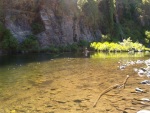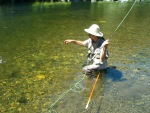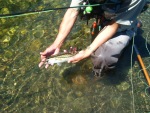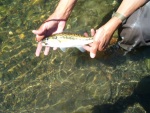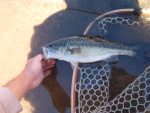Ran into a old friend today, Mark used to be a guide up here but in recent years has been putting his General Contractors license to use down south. Now he just comes up for a fishing trip now and then. “Let’s hit the lake” he says, and I, being really hard to talk into going fishing, says OK.
So after he finished his power nap on Mt Shasta (6,800 FT is a good elevation for a power nap I guess) we met at the Lake for a little Bass fishing.
I have said it before, but it bears repeating, throwing poppers for Smallmouth on a fly rod is a kick.
It was a bit windy at the start of the afternoon fishing, but Siskiyou has plenty of coves where you can get out of the wind. Of course the wind has a propensity to change direction as the evening progresses, so you have to switch coves occasionally to stay out of it.
Fishing was very good. The smallmouth were plenty willing to grab our Poppers. I was fishing the venerable Yellow Styrofoam Popper, which can be picked up at the local Walmart or sporting goods store for around a buck a dozen, while Mark was fishing a soft foam chartreuse popper. Did not seem to matter much. We were fairly well splitting the fish between us despite the fact that he was in the front of the boat and thus was getting first shot at the water. I overcame his advantage in position with a better understanding of the proper popper movement to trigger the hits. Not that we were competing or anything like that. Ahem, but I did take the evening big bass award, only to have Mark take the daily big fish award with a very nice 16-17″ Rainbow that decided to take his chartreuse popper. Silly fish, poppers are for Bass.
But that is not unusual for Lake Siskiyou. Right at dark, the trout will start feeding on the surface, and there is always the odd one that forgets he is feeding on midges, caddis, or mayflys and takes a popper. I have hooked some really nice Browns on Siskiyou that way.
The big bass of the evening was 12 1/2 inches. While Siskiyou is a great bass fishery, it does not produce many large smallmouth, I have caught smallies in the lake up to around 18″ but 9-11 inchers are much more common. Last year was a very good year size wise and we were getting good numbers of fish in the 14-16 inch range.
Since I have only done two trips to the lake so far this year it is too soon to tell if that will repeat.
Siskiyou is one of the rare lakes (at least in Northern California) that has a slot limit. You are not suppose to keep any smallie between 12 and 15 inches. Unfortunately there is very little public awareness of the slot limit and I suspect it is regularly ignored.
Some of the old timers around here tell me that the size of the bass runs in cycles. You will have several years of small fish that will eventually grow, and then you have a few years of good fish, then it will got back to a bunch of small fish. Anyone else hear of this kind of thing? I don’t know if that is indicative of a lake that is a bit over-populated or it just means that the majority of the fish are all the same age so they all die off of old age around the same time. It does not sound like that should happen in a natural population, but the smallies in Siskiyou are a imported non-native fish so they are not a natural population.





